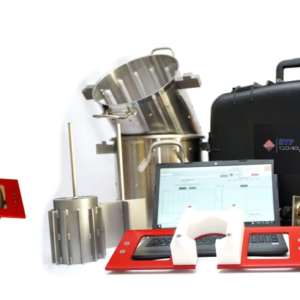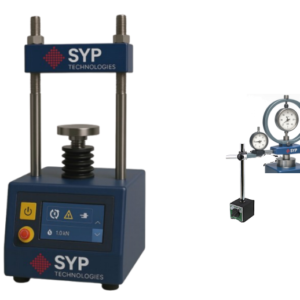Thermal Gravimetric Analyzer
S1-HT-102
- Top-Loading & Differential Balance System:Ensures automatic protection against condensation and contamination while canceling buoyancy and convection effects, eliminating the need for baseline runs.
- Cost-Effective & High Performance:Offers a reliable, fully equipped instrument package for simultaneous measurements up to 1600°C at an attractive price.
- Versatile Atmosphere Control:Supports inert, oxidizing, and vacuum environments with software-controlled mass flow controllers (MFCs) for dynamic or static gas changes during tests.
- Automatic Sample Changer (ASC):Optional ASC accommodates up to 20 samples, enabling unattended operation, pre-programmed testing, and enhanced throughput.
- Seamless Evolved Gas Analysis (EGA):Easily integrates with FT-IR, MS, or GC-MS systems to analyze gases released during thermal treatment.
For further details, download the complete PDF brochure
Description
Simultaneous thermal analysis refers to the simultaneous application of two or more thermoanalytical methods to the same sample in one instrument. This term, however, is in most cases used for simultaneous measurement of the mass changes and caloric effects on a sample under thermal treatment.
The benefits of such a system are obvious:
- Often, the material available for testing is expensive or difficult to produce. The transformation energetics and mass change are obtained on one sample in one run; the time necessary for the tests is cut in half.
- Influences of the measurement conditions and/or sample preparation can be eliminated. Comparability of characteristic temperatures of the mass changes and caloric effects is ensured.
- Problems resulting from differences in the sample composition for the two simultaneous measurements are removed for inhomogeneous materials.
Standard Solution with Trendsetting Technology
The Machine is equipped with a tailor-made ultra-micro balance with a resolution of 0.03 μg. The self-compensating differential balance operates with two symmetric balance arms, connected to the reference and sample rod in the furnace.
The compensation system (coil magnets) is controlled by a highresolution optical sensor. This avoids rod movements resulting in a stable, high-resolution balance with a weighing range of ± 250 mg. The differential balance set-up compensates for buoyancy effects, even during changes in gas flow.
SPECIFICATION
Design & Balance System
- Type:Top-loading, vertical design with differential balance system
- Balance System:High-precision differential balance for enhanced accuracy
Furnace Specifications
- Temperature Range:Room Temperature (RT) to 1100°C / 1600°C (with two easily exchangeable furnaces)
- Heating Rate:001 to 100 K/min (varies by furnace type)
- Temperature Precision (Repeatability):±0.3 K
- Furnace Hoist:Motorized single hoist for easy operation
Balance & Sensor Data
- Weighing Range:±250 mg, with a maximum sample load of 1 g
- Thermogravimetric Resolution:03 μg
- Temperature Sensor:Type S thermocouple
Atmosphere Control
- Vacuum Compatibility:Yes (dependent on the evacuation system)
- Supported Gas Atmospheres:Inert, oxidizing, and vacuum environments
- Gas Flow Control:Built-in mass flow controllers for precise regulation
Automation & Sample Handling
- Automatic Sample Changer (ASC):Optional ASC available for handling up to 20 crucibles, ensuring high-throughput analysis.
Applications
- Material Science & Engineering Studies: Enables students to validate theoretical principles through practical application.
- Research & Development: Suitable for laboratories conducting basic material strength analysis.
Mechanical & Civil Engineering Education: A vital tool for testing the mechanical properties of materials used in various industries.
DIMENSIONS
- L x W xH: (0.7 x 0.7 x 0.9) m






Leave a Reply